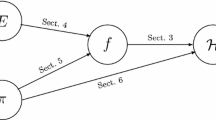Abstract
In this paper, we study issues related to the notion of “secure” hash functions. Several necessary conditions are considered, as well as a popular sufficient condition (the so-called random oracle model). We study the security of various problems that are motivated by the notion of a secure hash function. These problems are analyzed in the random oracle model, and we prove that the obvious trivial algorithms are optimal. As well, we look closely at reductions between various problems. In particular, we consider the important question “does collision resistance imply preimage resistance?”. We provide partial answers to this question – both positive and negative! – based on uniformity properties of the hash function under consideration.
Similar content being viewed by others
References
M. Bellare, T. Kohno Hash function balance and its impact on birthday attacks, In Advances in Cryptology – EUROCRYPT 2004, Lecture Notes in Computer Science, Vol. 3027 (2004) pp. 401–418.
M. Bellare and P. Rogaway, Random oracles are practical: a paradigm for designing efficient protocols, In Proceedings of the First Annual Conference on Computer and Communications Security, ACM Press (1993) pp. 62–73.
M. Bellare and P. Rogaway, Optimal asymmetric encryption, In Advances in Cryptology - EUROCRYPT ’94, Lecture Notes in Computer Science, Vol. 950 (1995) pp. 92–111.
D. Brown, Generic groups, collision resistance and ECDSA, Designs, Codes and Cryptography, Vol. 35 (2005) 119-152.
I. B. Damgård, A design principle for hash functions, In Advances in Cryptology -CRYPTO ’89, Lecture Notes in Computer Science, Vol. 435 (1990) pp. 416–427.
D. E. Knuth, The Art of Computer Programming, 3rd edn, Addison-Wesley (1997).
G. Laccetti and G. Schmid, On a probabilistic approach to the security analysis of cryptographic hash functions, In it Cryptology ePrint Archive, http://eprint.iacr.org/. Report 2004/324.
A. J. Menezes, P. C. van Oorschot and S. A. Vanstone, Handbook of Applied Cryptography, CRC Press (1997).
B. Preneel, The state of cryptographic hash functions, In Lectures on Data Security: Modern Cryptology in Theory and Practice, Lecture Notes in Computer Science, Vol. 1561 (1999) pp. 158–182.
P. Rogaway and T. Shrimpton, Cryptographic hash-function basics: definitions, implications, and separations for preimage resistance, second-preimage resistance, and collision-resistance, In FSE 2004, Lecture Notes in Computer Science Vol. 3017 (2004) pp. 371–388.
D. R. Simon, Finding collisions on a one-way street: can secure hash functions be based on general assumptions? In Advances in Cryptology - EUROCRYPT ’98. Lecture Notes in Computer Science, Vol. 1403 (1998) pp. 334–345.
D. R. Stinson, Cryptography: Theory and Practice, 2nd edn, CRC Press, (2002).
Author information
Authors and Affiliations
Corresponding author
Additional information
Communicated by: P. Wild
Rights and permissions
About this article
Cite this article
Stinson, D.R. Some Observations on the Theory of Cryptographic Hash Functions. Des Codes Crypt 38, 259–277 (2006). https://doi.org/10.1007/s10623-005-6344-y
Received:
Revised:
Accepted:
Issue Date:
DOI: https://doi.org/10.1007/s10623-005-6344-y




